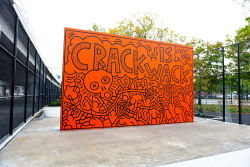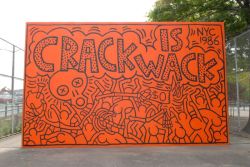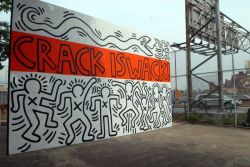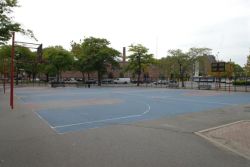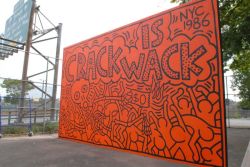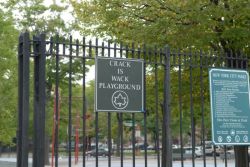Crack Is Wack Playground
Crack Is Wack Playground
Crack is Wack Playground earned its distinctive name after artist Keith Haring (1958-1990) painted the now-famous Crack Is Wack mural in 1986 on the handball court walls. The mural, done in Haring's signature style of thick black outlines, bright colors and intermingling, cartoon-like bodies, was painted to send a serious anti-drug message to the community.
Keith Haring was born in Reading, Pennsylvania, on May 4, 1958. His father, an amateur cartoonist, sparked his son's early interest in art. After high school, Haring enrolled in the Ivy School of Professional Art in Pittsburgh, but soon grew dissatisfied with the commercialism of his illustration and graphic design coursework. He withdrew from school and hitchhiked across the United States. He returned to Pittsburgh in 1976 where he became involved with the Pittsburgh Arts and Crafts Center and hosted his first art show at age 19.
In 1978, Haring came to New York with a scholarship to the School of Visual Arts. The graffiti he saw throughout the city immediately appealed to Haring's artistic sense of spontaneity and the possibilities for political messages. Soon Haring began using building facades and subway walls as canvases for his own graffiti art. Most of his subway graffiti was benign, as it was done in white chalk on the blank black background of unused advertising panels. Though Haring was arrested several times for illegally spray painting building walls, Haring continued to create his distinctive murals. Haring believed that art should be accessible to everyone, and his philosophy is reflected in both the simplicity of his figures and the public medium through which he chose to express himself. As his signature chalk outlines of interlocking bodies grew in fame, Haring gained the respect of the international art community and the appreciation of the public. One interpretation of Haring's work holds that he is suggesting how diverse groups of people can live together in harmony.
Haring painted this playground's mural on October 3, 1986 to call attention to the damage drugs can inflict on community welfare. He continued to create murals, sculptures, drawings, and paintings until he died of AIDS on February 16, 1990, at the age of 32. His artwork is highly prized throughout the world. The Keith Haring Foundation, which Haring created shortly before his death, continues to educate the public about Haring's life and work and raises money for children's and AIDS charities.
Crack Is Wack Playground, located on Second Avenue, 127th Street, and Harlem River Drive, is one of six parcels of land that collectively form Harlem River Park. The park is located along a 3.9-mile strip of Harlem River Drive, from East 125th Street to East 155th Street. Harlem River Drive was built in 1941, one of a number of transportation projects conceived by legendary political figure Robert Moses, Parks Commissioner from 1934 until 1960. Moses also built the Cross-Bronx Expressway, the Major Deegan Expressway, and the Alexander Hamilton Bridge at the same time. Harlem River Drive was designed to provide a link between the East River Drive (now FDR Drive) and the Harlem River Speedway (now the Harlem River Driveway) while allowing for the preservation and rehabilitation of the Harlem River waterfront.
This parcel of land was transferred to Parks in 1956 from the Board of Estimate. The handball court, basketball courts, and trees were added the following year. To ensure that the message of Haring's mural will continue to reach parkgoers, Parks and the Keith Haring Foundation restored the mural in July 1995.
Check out your park's Vital Signs
Clean & Safe
Green & Resilient
Empowered & Engaged Users
Share your feedback or learn more about how this park is part of a
Vital Park System

